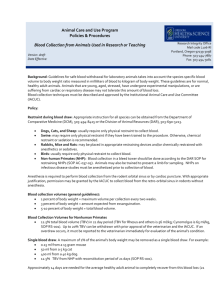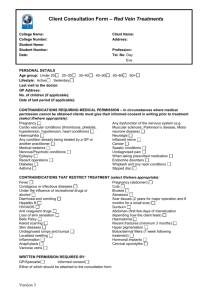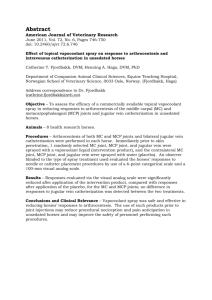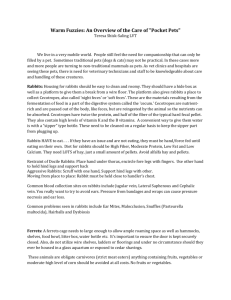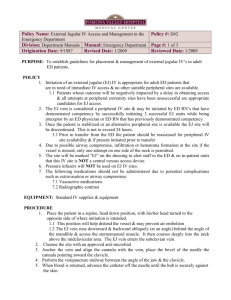external jugular vein communicating with internal jugular vein
advertisement
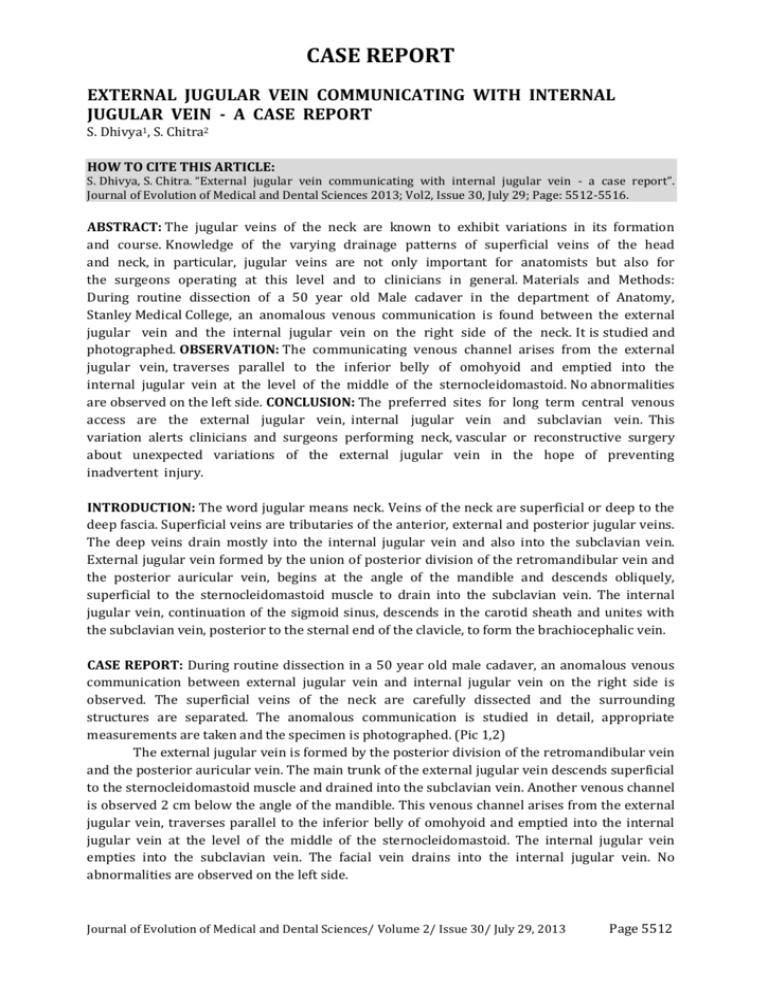
CASE REPORT EXTERNAL JUGULAR VEIN COMMUNICATING WITH INTERNAL JUGULAR VEIN - A CASE REPORT S. Dhivya1, S. Chitra2 HOW TO CITE THIS ARTICLE: S. Dhivya, S. Chitra. “External jugular vein communicating with internal jugular vein - a case report”. Journal of Evolution of Medical and Dental Sciences 2013; Vol2, Issue 30, July 29; Page: 5512-5516. ABSTRACT: The jugular veins of the neck are known to exhibit variations in its formation and course. Knowledge of the varying drainage patterns of superficial veins of the head and neck, in particular, jugular veins are not only important for anatomists but also for the surgeons operating at this level and to clinicians in general. Materials and Methods: During routine dissection of a 50 year old Male cadaver in the department of Anatomy, Stanley Medical College, an anomalous venous communication is found between the external jugular vein and the internal jugular vein on the right side of the neck. It is studied and photographed. OBSERVATION: The communicating venous channel arises from the external jugular vein, traverses parallel to the inferior belly of omohyoid and emptied into the internal jugular vein at the level of the middle of the sternocleidomastoid. No abnormalities are observed on the left side. CONCLUSION: The preferred sites for long term central venous access are the external jugular vein, internal jugular vein and subclavian vein. This variation alerts clinicians and surgeons performing neck, vascular or reconstructive surgery about unexpected variations of the external jugular vein in the hope of preventing inadvertent injury. INTRODUCTION: The word jugular means neck. Veins of the neck are superficial or deep to the deep fascia. Superficial veins are tributaries of the anterior, external and posterior jugular veins. The deep veins drain mostly into the internal jugular vein and also into the subclavian vein. External jugular vein formed by the union of posterior division of the retromandibular vein and the posterior auricular vein, begins at the angle of the mandible and descends obliquely, superficial to the sternocleidomastoid muscle to drain into the subclavian vein. The internal jugular vein, continuation of the sigmoid sinus, descends in the carotid sheath and unites with the subclavian vein, posterior to the sternal end of the clavicle, to form the brachiocephalic vein. CASE REPORT: During routine dissection in a 50 year old male cadaver, an anomalous venous communication between external jugular vein and internal jugular vein on the right side is observed. The superficial veins of the neck are carefully dissected and the surrounding structures are separated. The anomalous communication is studied in detail, appropriate measurements are taken and the specimen is photographed. (Pic 1,2) The external jugular vein is formed by the posterior division of the retromandibular vein and the posterior auricular vein. The main trunk of the external jugular vein descends superficial to the sternocleidomastoid muscle and drained into the subclavian vein. Another venous channel is observed 2 cm below the angle of the mandible. This venous channel arises from the external jugular vein, traverses parallel to the inferior belly of omohyoid and emptied into the internal jugular vein at the level of the middle of the sternocleidomastoid. The internal jugular vein empties into the subclavian vein. The facial vein drains into the internal jugular vein. No abnormalities are observed on the left side. Journal of Evolution of Medical and Dental Sciences/ Volume 2/ Issue 30/ July 29, 2013 Page 5512 CASE REPORT DISCUSSION: The external jugular vein is one of the variable veins. Bergman et al (1) has listed several variations of the external jugular vein. The variations that they have noted include: a. Its formation merely by the posterior auricular vein b. Receiving the facial, lingual or the cephalic veins as tributaries c. Passing over the clavicle and open into the cephalic, subclavian or internal jugular veins d. Doubling of the vein e. Formation of an annulus around the clavicle. The external jugular vein may be absent or smaller than usual and if so the anterior or internal jugular vein is enlarged (2).In a study conducted on 89 dissected adult cadavers, the external jugular vein receives facial vein in 9% of the cases (3).The formation of external jugular vein by union of entire retromandibular vein and facial vein (4) and a case of facial vein continuing as external jugular vein has also been reported (5). A case of duplication of external jugular vein in the middle third near the posterior border of sternocleidomastoid muscle has been reported (6). In a study of the dissection of 100 external jugular veins in 50 cadavers, the mode of termination of external jugular vein is defined; forty-three subjects presented a symmetric mechanism. 100 anastomoses can be classed into three types: in 60 cases (60%), the external jugular vein flows into the jugulo-subclavian venous confluence; in 36 cases (36%), in to the subclavian vein at a distance from its junction with the internal jugular vein; in 4 cases (4%) in to the trunk of the internal jugular vein(7). Cornelius Rosse and Penelope Gaddum-Rosse (8) have mentioned that a smaller superficial external jugular vein usually connects with the upper part of the internal jugular vein. John E. Skandalakis (9) has mentioned that in its course, the external jugular vein communicates with the internal jugular vein and receives a number of tributaries in the neck. It usually ends by piercing the superficial investing layer of deep fascia and joining the subclavian vein, although it can also terminate in the internal jugular vein. Rekha Lalwani et al (10) have reported a communicating channel between external and internal jugular vein. Henry Gray (11) stated that external jugular vein may communicate with the internal jugular vein. In the present case also, there is a similar finding. The communicating channel runs deep to the posterior border of the muscle in the present case but in the observation by Rekha Lalwani et al (10), the communicating channel is superficial to the muscle. The development of the veins of the scalp, face and neck has not been clearly understood nor has been the cause of their variations [12]. The principle cephalic vein which is formed early in the embryonic life disappears, thus necessitating the formation of venous spaces which connect and form channels, thus leading to the origin of the facial and pharyngeal veins [13]. Their enlargement at some places and diminution at others result in a retiform arrangement. Some primitive channels evolve and enlarge to form the definitive ones .Two main venous channels have been observed in this region in an embryo with a length of 10 mm i.e. the primitive maxillary vein and the ventral pharyngeal vein which drain the rapidly growing mandibular and the hyoid arches into the common cardinal vein [12]. Simultaneously, a small cranial tributary of the primitive cephalic vein in the arm at stage 6 has grown larger in the differentiating tissues of the neck and joins the jugulo cephalic vein which is crani dorsal to the cartilaginous clavicle, which is now surrounded by a venous ring. The caudoclavicular part of this ring is a new anastomosis whereby the definitive cephalic vein overcomes its jugulocephalic detour and becomes directly continuous with the subclavian vein now definitive. The old proximal end of the primitive cephalic vein, which is the cranio dorsal part of the clavicular venous ring, may be recognised as a trunk of the adult external jugular vein. Journal of Evolution of Medical and Dental Sciences/ Volume 2/ Issue 30/ July 29, 2013 Page 5513 CASE REPORT The part of the venous ring which is ventral and superficial to the clavicle i.e. the jugulo cephalic segment of the primitive cephalic vein often dwindles at stage 6 and is usually lost [14]. Further, the developing external jugular vein makes two connections, anterior and posterior with the facial vein and with the retromandibular vein respectively. Under normal circumstances, the anterior connection disappears so that the facial vein continues to drain via the common facial vein into the precardial vein (adult internal jugular vein), whereas the posterior connection persists, so that the retromandibular vein drains into the external jugular vein. In the present case, it seems that in the early embryonic life, the principle cephalic vein has disappeared and different venous spaces have been formed normally. However, there occurred failure on the part of some of these spaces to retrogress, which usually should have disappeared so that a communicating channel persists between external and internal jugular vein. According to Bernard J.Leininger and William E.Neville (15), in the case of internal jugular vein ligation during radical neck dissection, collateral drainage develops through oblique jugular vein from facial vein into the external jugular vein. CONCLUSION: Central venous access is indicated if peripheral access is unsuccessful or if hypertonic, irritant or vasoconstrictor solutions are used. The preferred sites for long term central venous access are the external jugular vein, internal jugular vein and subclavian vein. This variation alerts clinicians and surgeons performing neck, vascular or reconstructive surgery about unexpected variations of the external jugular vein in the hope of preventing inadvertent injury. REFERENCES: 1. Bergman RA, Afifi AK, Miyauchi R. Illustrated encyclopedia of human anatomic variation: opus II: cardiovascular system: veins: Head, neck and thorax. http://www.anatomyatlases.org/Anatomic Variants/Cardiovascular/Text/Veins/Jugular External.html.(accessed on December 15,2011) 2. Romanes GJ. Cunningham’s Textbook of Anatomy.12th edition, Oxford Publications; 1964: 948 3. 3.Gupta V, Tuli A, Choudhry R, Agarwal S, Mangal A. Facial vein draining into external jugular vein in humans; its variations, phylogenetic retention and clinical relevance, Surg. Radiol. Anat. 2003 Apr;25(1): 36-41 4. Yadav S, Ghosh SK, Anand C. Variations of superficial veins of head and neck. J. Anat. Soc. India. 2000; 49: 61–62. 5. Vollala VR, Bolla SR, Pamidi N. Important vascular anomalies of face and neck – a cadaveric study with clinical implications. Firat Tip Dergisi. 2008; 13:123–126. 6. Comert E, Comert A. External jugular vein duplication. J Craniofac Surg .2009 Nov; 20(6): 2173-4. 7. Deslaugiers B, Vaysse P, Combes JM, Guitard J, Moscovili J, Visentin M et al. contribution to the study of the tributaries and the termination of the external jugular vein. Surg Radiol Anat .1994;16(2): 173-7 8. Cornelius Rosse and Penelope Gaddum-Rosse. Hollinshead’s Textbook of Anatomy. 5th edition, Lippincott-Raven publishers;1997: 81 9. John E. Skandalakis. Skandalakis’ Surgical Anatomy vol I. Paschalidis Medical Publications; 2004: 37 Journal of Evolution of Medical and Dental Sciences/ Volume 2/ Issue 30/ July 29, 2013 Page 5514 CASE REPORT 10. Rekha Lalwani et al. communication of the external and internal jugular veins: A Case report. Int. J.Morphol.2006;24(4): 721-722 11. Henry Gray. Gray’s textbook of Anatomy. 40th edition,Elsevier;2008: 451 12. Choudhry R, Tuli A, Choudhry S. Facial vein terminating in external jugular vein-An embryonic interpretation. Surg. Radiol. Anat 1997;19:73-77 13. Frazer JE. A manual of embryology. In: The development of human body. London: Bailliere Tindal and co.London;1931:321 14. Padget DH. Contribution to embryology. In: Development of the cranial venous system in man, from the view point of comparative anatomy. Cornegile Institute of Washington,Baltimore;1957:106-110 15. Bernard J. Leininger and William E. Neville .use of the internal jugular vein for implantation of permanent transvenous pacemakers. Ann. Thorac. Surg. 1968;5: 61-65 Picture 1- Showing the communication between the external and internal jugular vein SCM-Sternocleidomastoid muscle EJV-External jugular vein IJV-Internal jugular vein CC-Communicating channel IBOO-Inferior belly of omohyoid Journal of Evolution of Medical and Dental Sciences/ Volume 2/ Issue 30/ July 29, 2013 Page 5515 CASE REPORT Picture 2- Showing the communication between the external and Internal jugular vein-closer view SCM-Sternocleidomastoid muscle EJV-External jugular vein IJV-Internal jugular vein CC-Communicating channel AUTHORS: 1. S. Dhivya 2. S. Chitra PARTICULARS OF CONTRIBUTORS: 1. Assistant Professor, Department of Anatomy, Government Mohan Kumaramangalam Medical College, Salem – 30. 2. Professor and Head of Department of Anatomy, Stanley Medical College, Chennai-1, NAME ADRRESS EMAIL ID OF THE CORRESPONDING AUTHOR: Dr. S. Dhivya, Assistant Professor of Anatomy, Government Mohan Kumaramangalam Medical College, Salem – 30 Email- drsdhivya@yahoo.co.in Date of Submission: 10/07/2013. Date of Peer Review: 11/07/2013. Date of Acceptance: 17/07/2013. Date of Publishing: 23/07/2013 Journal of Evolution of Medical and Dental Sciences/ Volume 2/ Issue 30/ July 29, 2013 Page 5516
